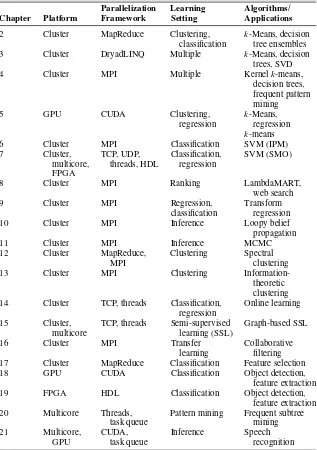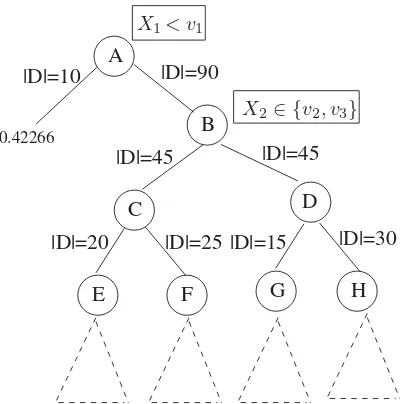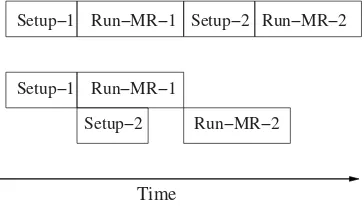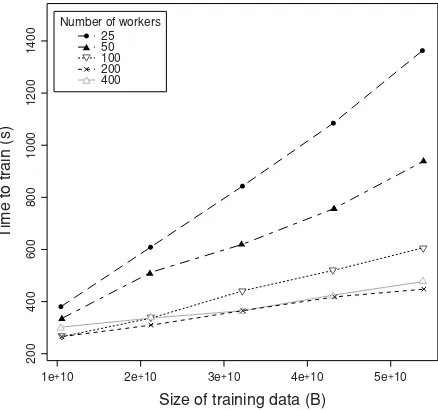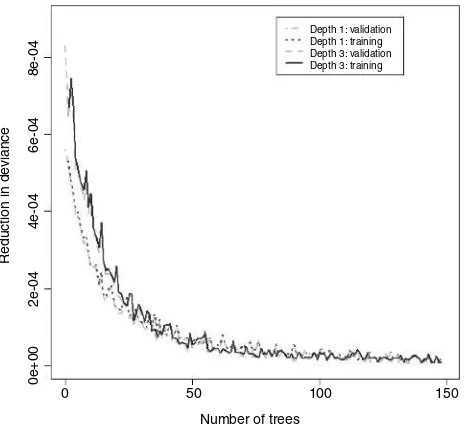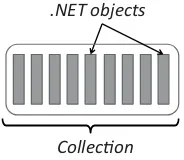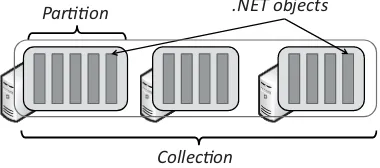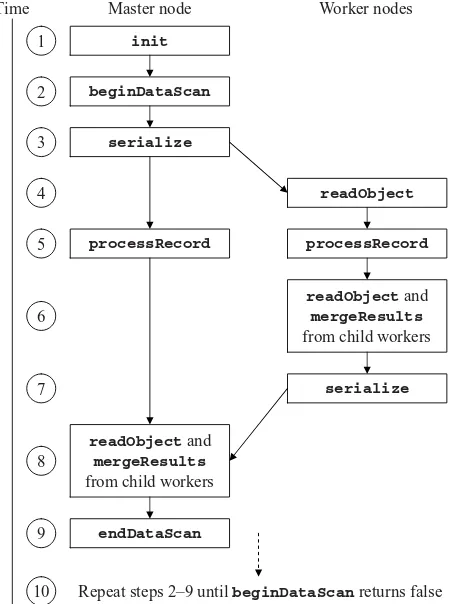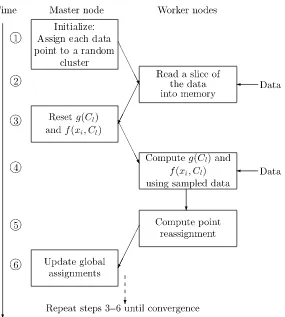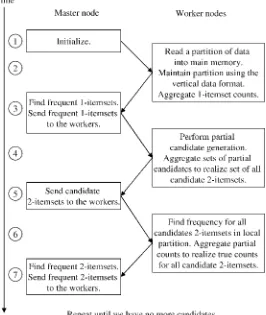Scaling Up Machine Learning
Parallel and Distributed ApproachesThis book comprises a collection of representative approaches for scaling up machine learn-ing and data minlearn-ing methods on parallel and distributed computlearn-ing platforms. Demand for parallelizing learning algorithms is highly task-specific: in some settings it is driven by the enormous dataset sizes, in others by model complexity or by real-time performance require-ments. Making task-appropriate algorithm and platform choices for large-scale machine learning requires understanding the benefits, trade-offs, and constraints of the available options.
Solutions presented in the book cover a range of parallelization platforms from FPGAs and GPUs to multi-core systems and commodity clusters; concurrent programming frame-works that include CUDA, MPI, MapReduce, and DryadLINQ; and various learning set-tings: supervised, unsupervised, semi-supervised, and online learning. Extensive coverage of parallelization of boosted trees, support vector machines, spectral clustering, belief propagation, and other popular learning algorithms accompanied by deep dives into several applications make the book equally useful for researchers, students, and practitioners.
Dr. Ron Bekkerman is a computer engineer and scientist whose experience spans across dis-ciplines from video processing to business intelligence. Currently a senior research scientist at LinkedIn, he previously worked for a number of major companies including Hewlett-Packard and Motorola. Ron’s research interests lie primarily in the area of large-scale unsupervised learning. He is the corresponding author of several publications in top-tier venues, such as ICML, KDD, SIGIR, WWW, IJCAI, CVPR, EMNLP, and JMLR.
Dr. Mikhail Bilenko is a researcher in the Machine Learning Group at Microsoft Research. His research interests center on machine learning and data mining tasks that arise in the context of large behavioral and textual datasets. Mikhail’s recent work has focused on learning algorithms that leverage user behavior to improve online advertising. His papers have been published in KDD, ICML, SIGIR, and WWW among other venues, and I have received best paper awards from SIGIR and KDD.
Dr. John Langford is a computer scientist working as a senior researcher at Yahoo! Re-search. Previously, he was affiliated with the Toyota Technological Institute and IBM T. J. Watson Research Center. John’s work has been published in conferences and journals including ICML, COLT, NIPS, UAI, KDD, JMLR, and MLJ. He received the Pat Goldberg Memorial Best Paper Award, as well as best paper awards from ACM EC and WSDM. He is also the author of the popular machine learning weblog, hunch.net.
Scaling Up Machine Learning
Parallel and Distributed Approaches
Edited by
Ron Bekkerman
Mikhail Bilenko
John Langford
cambridge university press
Cambridge, New York, Melbourne, Madrid, Cape Town, Singapore, S˜ao Paulo, Delhi, Tokyo, Mexico City
Cambridge University Press
32 Avenue of the Americas, New York, NY 10013-2473, USA
www.cambridge.org
Information on this title:www.cambridge.org/9780521192248
C
Cambridge University Press 2012
This publication is in copyright. Subject to statutory exception and to the provisions of relevant collective licensing agreements, no reproduction of any part may take place without the written permission of Cambridge University Press.
First published 2012
Printed in the United States of America
A catalog record for this publication is available from the British Library.
Library of Congress Cataloging in Publication data
Scaling up machine learning : parallel and distributed approaches / [edited by] Ron Bekkerman, Mikhail Bilenko, John Langford.
p. cm. Includes index.
ISBN 978-0-521-19224-8 (hardback)
1. Machine learning. 2. Data mining. 3. Parallel algorithms. 4. Parallel programs (Computer programs) I. Bekkerman, Ron. II. Bilenko, Mikhail. III. Langford, John.
Q325.5.S28 2011
006.3′1–dc23 2011016323 ISBN 978-0-521-19224-8 Hardback
Cambridge University Press has no responsibility for the persistence or accuracy of URLs for external or third-party Internet Web sites referred to in this publication and does not guarantee that any content on such Web sites is, or will remain, accurate or appropriate.
Contents
Contributors xi
Preface xv
1 Scaling Up Machine Learning: Introduction 1 Ron Bekkerman, Mikhail Bilenko, and John Langford
1.1 Machine Learning Basics 2
1.2 Reasons for Scaling Up Machine Learning 3
1.3 Key Concepts in Parallel and Distributed Computing 6
1.4 Platform Choices and Trade-Offs 7
1.5 Thinking about Performance 9
1.6 Organization of the Book 10
1.7 Bibliographic Notes 17
References 19
Part One Frameworks for Scaling Up Machine Learning
2 MapReduce and Its Application to Massively Parallel Learningof Decision Tree Ensembles 23
Biswanath Panda, Joshua S. Herbach, Sugato Basu, and Roberto J. Bayardo
2.1 Preliminaries 24
2.2 Example of PLANET 30
2.3 Technical Details 33
2.4 Learning Ensembles 38
2.5 Engineering Issues 39
2.6 Experiments 41
2.7 Related Work 44
2.8 Conclusions 46
Acknowledgments 47
References 47
v
vi contents
3 Large-Scale Machine Learning Using DryadLINQ 49 Mihai Budiu, Dennis Fetterly, Michael Isard,
Frank McSherry, and Yuan Yu
3.1 Manipulating Datasets with LINQ 49
3.2 k-Means in LINQ 52
3.3 Running LINQ on a Cluster with DryadLINQ 53
3.4 Lessons Learned 65
References 67
4 IBM Parallel Machine Learning Toolbox 69 Edwin Pednault, Elad Yom-Tov, and Amol Ghoting
4.1 Data-Parallel Associative-Commutative Computation 70
4.2 API and Control Layer 71
4.3 API Extensions for Distributed-State Algorithms 76
4.4 Control Layer Implementation and Optimizations 77
4.5 Parallel Kernelk-Means 79
4.6 Parallel Decision Tree 80
4.7 Parallel Frequent Pattern Mining 83
4.8 Summary 86
References 87
5 Uniformly Fine-Grained Data-Parallel Computing for Machine
Learning Algorithms 89
Meichun Hsu, Ren Wu, and Bin Zhang
5.1 Overview of a GP-GPU 91
5.2 Uniformly Fine-Grained Data-Parallel Computing on a GPU 93
5.3 Thek-Means Clustering Algorithm 97
5.4 Thek-Means Regression Clustering Algorithm 99
5.5 Implementations and Performance Comparisons 102
5.6 Conclusions 105
References 105
Part Two Supervised and Unsupervised Learning Algorithms
6 PSVM: Parallel Support Vector Machines with IncompleteCholesky Factorization 109
Edward Y. Chang, Hongjie Bai, Kaihua Zhu, Hao Wang, Jian Li, and Zhihuan Qiu
6.1 Interior Point Method with Incomplete Cholesky Factorization 112
6.2 PSVM Algorithm 114
6.3 Experiments 121
6.4 Conclusion 125
Acknowledgments 125
References 125
7 Massive SVM Parallelization Using Hardware Accelerators 127 Igor Durdanovic, Eric Cosatto, Hans Peter Graf, Srihari Cadambi,
Venkata Jakkula, Srimat Chakradhar, and Abhinandan Majumdar
7.1 Problem Formulation 128
7.2 Implementation of the SMO Algorithm 131
contents vii
7.3 Micro Parallelization: Related Work 132
7.4 Previous Parallelizations on Multicore Systems 133
7.5 Micro Parallelization: Revisited 136
7.6 Massively Parallel Hardware Accelerator 137
7.7 Results 145
7.8 Conclusion 146
References 146
8 Large-Scale Learning to Rank Using Boosted Decision Trees 148 Krysta M. Svore and Christopher J. C. Burges
8.1 Related Work 149
8.2 LambdaMART 151
8.3 Approaches to Distributing LambdaMART 153
8.4 Experiments 158
8.5 Conclusions and Future Work 168
8.6 Acknowledgments 169
References 169
9 The Transform Regression Algorithm 170
Ramesh Natarajan and Edwin Pednault
9.1 Classification, Regression, and Loss Functions 171
9.2 Background 172
9.3 Motivation and Algorithm Description 173
9.4 TReg Expansion: Initialization and Termination 177
9.5 Model Accuracy Results 184
9.6 Parallel Performance Results 186
9.7 Summary 188
References 189
10 Parallel Belief Propagation in Factor Graphs 190 Joseph Gonzalez, Yucheng Low, and Carlos Guestrin
10.1 Belief Propagation in Factor Graphs 191
10.2 Shared Memory Parallel Belief Propagation 195
10.3 Multicore Performance Comparison 209
10.4 Parallel Belief Propagation on Clusters 210
10.5 Conclusion 214
Acknowledgments 214
References 214
11 Distributed Gibbs Sampling for Latent Variable Models 217 Arthur Asuncion, Padhraic Smyth, Max Welling, David Newman,
Ian Porteous, and Scott Triglia
11.1 Latent Variable Models 217
11.2 Distributed Inference Algorithms 220
11.3 Experimental Analysis of Distributed Topic Modeling 224
11.4 Practical Guidelines for Implementation 229
11.5 A Foray into Distributed Inference for Bayesian Networks 231
11.6 Conclusion 236
Acknowledgments 237
References 237
viii contents
12 Large-Scale Spectral Clustering with MapReduce and MPI 240 Wen-Yen Chen, Yangqiu Song, Hongjie Bai, Chih-Jen Lin,
and Edward Y. Chang
12.1 Spectral Clustering 241
12.2 Spectral Clustering Using a Sparse Similarity Matrix 243 12.3 Parallel Spectral Clustering (PSC) Using a Sparse Similarity Matrix 245
12.4 Experiments 251
12.5 Conclusions 258
References 259
13 Parallelizing Information-Theoretic Clustering Methods 262 Ron Bekkerman and Martin Scholz
13.1 Information-Theoretic Clustering 264
13.2 Parallel Clustering 266
13.3 Sequential Co-clustering 269
13.4 The DataLoom Algorithm 270
13.5 Implementation and Experimentation 274
13.6 Conclusion 277
References 278
Part Three Alternative Learning Settings
14 Parallel Online Learning 283
Daniel Hsu, Nikos Karampatziakis, John Langford, and Alex J. Smola
14.1 Limits Due to Bandwidth and Latency 285
14.2 Parallelization Strategies 286
14.3 Delayed Update Analysis 288
14.4 Parallel Learning Algorithms 290
14.5 Global Update Rules 298
14.6 Experiments 302
14.7 Conclusion 303
References 305
15 Parallel Graph-Based Semi-Supervised Learning 307 Jeff Bilmes and Amarnag Subramanya
15.1 Scaling SSL to Large Datasets 309
15.2 Graph-Based SSL 310
15.3 Dataset: A 120-Million-Node Graph 317
15.4 Large-Scale Parallel Processing 319
15.5 Discussion 327
References 328
16 Distributed Transfer Learning via Cooperative Matrix
Factorization 331
Evan Xiang, Nathan Liu, and Qiang Yang
16.1 Distributed Coalitional Learning 333
16.2 Extension of DisCo to Classification Tasks 343
contents ix
16.3 Conclusion 350
References 350
17 Parallel Large-Scale Feature Selection 352 Jeremy Kubica, Sameer Singh, and Daria Sorokina
17.1 Logistic Regression 353
17.2 Feature Selection 354
17.3 Parallelizing Feature Selection Algorithms 358
17.4 Experimental Results 363
17.5 Conclusions 368
References 368
Part Four Applications
18 Large-Scale Learning for Vision with GPUs 373 Adam Coates, Rajat Raina, and Andrew Y. Ng
18.1 A Standard Pipeline 374
18.2 Introduction to GPUs 377
18.3 A Standard Approach Scaled Up 380
18.4 Feature Learning with Deep Belief Networks 388
18.5 Conclusion 395
References 395
19 Large-Scale FPGA-Based Convolutional Networks 399 Cl´ement Farabet, Yann LeCun, Koray Kavukcuoglu,
Berin Martini, Polina Akselrod, Selcuk Talay, and Eugenio Culurciello
19.1 Learning Internal Representations 400
19.2 A Dedicated Digital Hardware Architecture 405
19.3 Summary 416
References 417
20 Mining Tree-Structured Data on Multicore Systems 420 Shirish Tatikonda and Srinivasan Parthasarathy
20.1 The Multicore Challenge 422
20.2 Background 423
20.3 Memory Optimizations 427
20.4 Adaptive Parallelization 431
20.5 Empirical Evaluation 437
20.6 Discussion 442
Acknowledgments 443
References 443
21 Scalable Parallelization of Automatic Speech Recognition 446 Jike Chong, Ekaterina Gonina, Kisun You, and Kurt Keutzer
21.1 Concurrency Identification 450
21.2 Software Architecture and Implementation Challenges 452
21.3 Multicore and Manycore Parallel Platforms 454
21.4 Multicore Infrastructure and Mapping 455
x contents
21.5 The Manycore Implementation 459
21.6 Implementation Profiling and Sensitivity Analysis 462
21.7 Application-Level Optimization 464
21.8 Conclusion and Key Lessons 467
References 468
Contributors
Polina Akselrod
Yale University, New Haven, CT, USA
Arthur Asuncion
University of California, Irvine, CA, USA
Hongjie Bai
Google Research, Beijing, China
Sugato Basu
Google Research, Mountain View, CA, USA
Roberto J. Bayardo
Google Research, Mountain View, CA, USA
Ron Bekkerman
LinkedIn Corporation, Mountain View, CA, USA
Mikhail Bilenko
Microsoft Research, Redmond, WA, USA
Jeff Bilmes
University of Washington, Seattle, WA, USA
Mihai Budiu
Microsoft Research, Mountain View, CA, USA
Christopher J. C. Burges
Microsoft Research, Redmond, WA, USA
Srihari Cadambi
NEC Labs America, Princeton, NJ, USA
Srimat Chakradhar
NEC Labs America, Princeton, NJ, USA
Edward Y. Chang
Google Research, Beijing, China
Wen-Yen Chen
University of California, Santa Barbara, CA, USA
Jike Chong
Parasians LLC, Sunnyvale, CA, USA
Adam Coates
Stanford University. Stanford, CA, USA
Eric Cosatto
NEC Labs America, Princeton, NJ, USA
Eugenio Culurciello
Yale University, New Haven, CT, USA
Igor Durdanovic
NEC Labs America, Princeton, NJ, USA
Cl´ement Farabet
New York University, New York, NY, USA
xii contributors
NEC Labs America, Princeton, NJ, USA
Carlos Guestrin
Carnegie Mellon University, Pittsburgh, PA, USA
Joshua S. Herbach
Google Inc., Mountain View, CA, USA
Daniel Hsu
Rutgers University, Piscataway, NJ, USA and University of Pennsylvania,
Philadelphia, PA, USA
Meichun Hsu
HP Labs, Palo Alto, CA, USA
Michael Isard
Microsoft Research, Mountain View, CA, USA
Venkata Jakkula
NEC Labs America, Princeton, NJ, USA
Nikos Karampatziakis
Cornell University, Ithaca, NY, USA
Koray Kavukcuoglu
NEC Labs America, Princeton, NJ, USA
Kurt Keutzer
Yahoo! Research, New York, NY, USA
Yann LeCun
New York University, New York, NY, USA
Hong Kong University of Science and Technology, Kowloon, Hong Kong
Yucheng Low
Carnegie Mellon University, Pittsburgh, PA, USA
Abhinandan Majumdar
NEC Labs America, Princeton, NJ, USA
Berin Martini
Yale University, New Haven, CT, USA
Frank McSherry
Google Inc., Mountain View, CA, USA
contributors xiii
Facebook Inc., Palo Alto, CA, USA
Martin Scholz
HP Labs, Palo Alto, CA, USA
Sameer Singh
University of Massachusetts, Amherst, MA, USA
Alex J. Smola
Yahoo! Research, Santa Clara, NY, USA
Padhraic Smyth
Yandex Labs, Palo Alto, CA, USA
Amarnag Subramanya
Yale University, New Haven, CT, USA
Shirish Tatikonda
IBM Research, San Jose, CA, USA
Scott Triglia
HP Labs, Palo Alto, CA, USA
Evan Xiang
Hong Kong University of Science and Technology, Kowloon, Hong Kong
Qiang Yang
Hong Kong University of Science and Technology, Kowloon, Hong Kong
Elad Yom-Tov
Yahoo! Research, New York, NY, USA
Kisun You
HP Labs, Palo Alto, CA, USA
Kaihua Zhu
Preface
This book attempts to aggregate state-of-the-art research in parallel and distributed machine learning. We believe that parallelization provides a key pathway for scaling up machine learning to large datasets and complex methods. Although large-scale ma-chine learning has been increasingly popular in both industrial and academic research communities, there has been no singular resource covering the variety of approaches recently proposed. We did our best to assemble the most representative contemporary studies in one volume. While each contributed chapter concentrates on a distinct ap-proach and problem, together with their references they provide a comprehensive view of the field.
We believe that the book will be useful to the broad audience of researchers, practi-tioners, and anyone who wants to grasp the future of machine learning. To smooth the ramp-up for beginners, the first five chapters provide introductory material on machine learning algorithms and parallel computing platforms. Although the book gets deeply technical in some parts, the reader is assumed to have only basic prior knowledge of machine learning and parallel/distributed computing, along with college-level mathe-matical maturity. We hope that an engineering undergraduate who is familiar with the notion of a classifier and had some exposure to threads, MPI, or MapReduce will be able to understand the majority of the book’s content. We also hope that a seasoned expert will find this book full of new, interesting ideas to inspire future research in the area.
We are deeply thankful to all chapter authors for significant investments of their time, talent, and creativity in preparing their contributions to this volume. We appre-ciate the efforts of our editors at Cambridge University Press: Heather Bergman, who initiated this project, and Lauren Cowles, who worked with us throughout the process, guiding the book to completion. We thank chapter reviewers who provided detailed, thoughtful feedback to chapter authors that was invaluable in shaping the book: David Andrzejewski, Yoav Artzi, Arthur Asuncion, Hongjie Bai, Sugato Basu, Andrew Ben-der, Mark Chapman, Wen-Yen Chen, Sulabh Choudhury, Adam Coates, Kamalika Das, Kevin Duh, Igor Durdanovic, Cl´ement Farabet, Dennis Fetterly, Eric Garcia, Joseph Gonzalez, Isaac Greenbaum, Caden Howell, Ferris Jumah, Andrey Kolobov, Jeremy
xvi preface
Kubica, Bo Li, Luke McDowell, W. P. McNeill, Frank McSherry, Chris Meek, Xu Miao, Steena Monteiro, Miguel Osorio, Sindhu Vijaya Raghavan, Paul Rodrigues, Martin Scholz, Suhail Shergill, Sameer Singh, Tom Sommerville, Amarnag Subra-manya, Narayanan Sundaram, Krysta Svore, Shirish Tatikonda, Amund Tveit, Jean Wu, Evan Xiang, Elad Yom-Tov, and Bin Zhang.
CHAPTER 1
Scaling Up Machine Learning:
Introduction
Ron Bekkerman, Mikhail Bilenko, and John Langford
Distributed and parallel processing of very large datasets has been employed for decades in specialized, high-budget settings, such as financial and petroleum industry applica-tions. Recent years have brought dramatic progress in usability, cost effectiveness, and diversity of parallel computing platforms, with their popularity growing for a broad set of data analysis and machine learning tasks.
The current rise in interest in scaling up machine learning applications can be partially attributed to the evolution of hardware architectures and programming frame-works that make it easy to exploit the types of parallelism realizable in many learning algorithms. A number of platforms make it convenient to implement concurrent pro-cessing of data instances or their features. This allows fairly straightforward paralleliza-tion of many learning algorithms that view input as an unordered batch of examples and aggregate isolated computations over each of them.
Increased attention to large-scale machine learning is also due to the spread of very large datasets across many modern applications. Such datasets are often accumulated on distributed storage platforms, motivating the development of learning algorithms that can be distributed appropriately. Finally, the proliferation of sensing devices that perform real-time inference based on high-dimensional, complex feature representa-tions drives additional demand for utilizing parallelism in learning-centric applicarepresenta-tions. Examples of this trend include speech recognition and visual object detection becoming commonplace in autonomous robots and mobile devices.
The abundance of distributed platform choices provides a number of options for im-plementing machine learning algorithms to obtain efficiency gains or the capability to process very large datasets. These options include customizable integrated circuits (e.g., Field-Programmable Gate Arrays – FPGAs), custom processing units (e.g., general-purpose Graphics Processing Units – GPUs), multiprocessor and multicore parallelism, High-Performance Computing (HPC) clusters connected by fast local networks, and datacenter-scale virtual clusters that can be rented from commercial cloud computing providers. Aside from the multiple platform options, there exists a variety of program-ming frameworks in which algorithms can be implemented. Framework choices tend
2 1 scaling up machine learning: introduction
to be particularly diverse for distributed architectures, such as clusters of commodity PCs.
The wide range of platforms and frameworks for parallel and distributed comput-ing presents both opportunities and challenges for machine learncomput-ing scientists and engineers. Fully exploiting the available hardware resources requires adapting some algorithms and redesigning others to enable their concurrent execution. For any pre-diction model and learning algorithm, their structure, dataflow, and underlying task decomposition must be taken into account to determine the suitability of a particular infrastructure choice.
Chapters making up this volume form a representative set of state-of-the-art solutions that span the space of modern parallel computing platforms and frameworks for a variety of machine learning algorithms, tasks, and applications. Although it is infeasible to cover every existing approach for every platform, we believe that the presented set of techniques covers most commonly used methods, including the popular “top performers” (e.g., boosted decision trees and support vector machines) and common “baselines” (e.g.,k-means clustering).
Because most chapters focus on a single choice of platform and/or framework, the rest of this introduction provides the reader with unifying context: a brief overview of machine learning basics and fundamental concepts in parallel and distributed com-puting, a summary of typical task and application scenarios that require scaling up learning, and thoughts on evaluating algorithm performance and platform trade-offs. Following these are an overview of the chapters and bibliography notes.
1.1 Machine Learning Basics
Machine learning focuses on constructing algorithms for making predictions from data. A machine learning task aims to identify (tolearn) a function f:X →Y that maps input domainX (of data) onto output domainY (of possible predictions). The function f is selected from a certain function class, which is different for each family of learning algorithms. Elements ofX andYare application-specific representations of data objects and predictions, respectively.
Two canonical machine learning settings aresupervised learningandunsupervised learning. Supervised learning algorithms utilizetraining datato construct a prediction function f, which is subsequently applied totestinstances. Typically, training data is provided in the form oflabeled examples(x,y)∈X ×Y, wherexis a data instance andyis the correspondingground truthprediction forx.
The ultimate goal of supervised learning is to identify a function f that produces accurate predictions on test data. More formally, the goal is to minimize the prediction error (loss) functionl :Y×Y→R, which quantifies the difference between any f(x)
1.2 reasons for scaling up machine learning 3
distribution P over X ×Y. The objective is to find f that minimizesexpected loss
E(x,y)∼Pl(f(x),y). Because the joint distributionPis unknown, expected loss cannot
be minimized in closed form; hence, learning algorithms approximate it based on training examples. Additional supervised learning settings include semi-supervised learning (where the input data consists of both labeled and unlabeled instances),
transfer learning, andonline learning(seeSection 1.6.3).
Two classic supervised learning tasks areclassificationandregression. In classifica-tion, the output domain is a finite discrete set of categories (classes),Y = {c1, ...,ck}, whereas in regression the output domain is the set of real numbers, Y=R. More
complex output domains are explored within advanced learning frameworks, such as
structured learning(Bakir et al.,2007).
The simplest classification scenario isbinary, in which there are two classes. Let us consider a small example. Assume that the task is to learn a function that predicts whether an incoming email message is spam or not. A common way to represent textual messages is as large, sparse vectors, in which every entry corresponds to a vocabulary word, and non-zero entries represent words that are present in the message. The label can be represented as 1 for spam and −1 for nonspam. With this representation, it is common to learn a vector of weights woptimizing f(x)=signiwixi
so as to predict the label.
The most prominent example of unsupervised learning isdata clustering. In clus-tering, the goal is to construct a function f that partitions anunlabeled dataset into
k= |Y|clusters, withYbeing the set of cluster indices. Data instances assigned to the same cluster should presumably be more similar to each other than to data instances assigned to any other cluster. There are many ways to define similarity between data instances; for example, for vector data, (inverted) Euclidean distance and cosine simi-larity are commonly used. Clustering quality is often measured against a dataset with existing class labels that are withheld during clustering: a quality measure penalizes f
if it assigns instances of the same class to different clusters and instances of different classes to the same cluster.
We note that both supervised and unsupervised learning settings distinguish between
learning andinferencetasks, where learning refers to the process of identifying the prediction function f, while inference refers to computing f(x)on a data instancex. For many learning algorithms, inference is a component of the learning process, as predictions of some interim candidate f′ on the training data are used in the search for the optimal f. Depending on the application domain, scaling up may be required for either the learning or the inference algorithm, and chapters in this book present numerous examples of speeding up both.
1.2 Reasons for Scaling Up Machine Learning
There are a number of settings where a practitioner could find the scale of a ma-chine learning task daunting for single-mama-chine processing and consider employing parallelization. Such settings are characterized by:
1. Large number of data instances:In many domains, the number of potential training examples is extremely large, making single-machine processing infeasible.
4 1 scaling up machine learning: introduction
2. High input dimensionality:In some applications, data instances are represented by a very large number of features. Machine learning algorithms may partition computation across the set of features, which allows scaling up to lengthy data representations. 3. Model and algorithm complexity:A number of high-accuracy learning algorithms
either rely on complex, nonlinear models, or employ computationally expensive subrou-tines. In both cases, distributing the computation across multiple processing units can be the key enabler for learning on large datasets.
4. Inference time constraints:Applications that involve sensing, such as robot navigation or speech recognition, require predictions to be made in real time. Tight constraints on inference speed in such settings invite parallelization of inference algorithms.
5. Prediction cascades:Applications that require sequential, interdependent predictions have highly complex joint output spaces, and parallelization can significantly speed up inference in such settings.
6. Model selection and parameter sweeps:Tuning hyper-parameters of learning algo-rithms and statistical significance evaluation require multiple executions of learning and inference. Fortunately, these procedures belong to the category of so-called embarrass-ingly parallelizableapplications, naturally suited for concurrent execution.
The following sections discuss each of these scenarios in more detail.
1.2.1 Large Number of Data Instances
Datasets that aggregate billions of events per day have become common in a number of domains, such as internet and finance, with each event being a potential input to a learning algorithm. Also, more and more devices include sensors continuously logging observations that can serve as training data. Each data instance may have, for example, thousands of non-zero features on average, resulting in datasets of 1012instance–feature pairs per day. Even if each feature takes only 1 byte to store, datasets collected over time can easily reach hundreds of terabytes.
The preferred way to effectively process such datasets is to combine the distributed storage and bandwidth of a cluster of machines. Several computational frameworks have recently emerged to ease the use of large quantities of data, such as MapReduce and DryadLINQ, used in several chapters in this book. Such frameworks combine the ability to use high-capacity storage and execution platforms with programming via simple, naturally parallelizable language primitives.
1.2.2 High Input Dimensionality
1.2 reasons for scaling up machine learning 5
1.2.3 Model and Algorithm Complexity
Data in some domains has inherently nonlinear structure with respect to the basic fea-tures (e.g., pixels or words). Models that employ highly nonlinear representations, such as decision tree ensembles or multi-layer (deep) networks, can significantly outperform simpler algorithms in such applications. Although feature engineering can yield high accuracies with computationally cheap linear models in these domains, there is a grow-ing interest in learngrow-ing as automatically as possible from the base representation. A common characteristic of algorithms that attempt this is their substantial computational complexity. Although the training data may easily fit on one machine, the learning pro-cess may simply be too slow for a reasonable development cycle. This is also the case for some learning algorithms, the computational complexity of which is superlinear in the number of training examples.
For problems of this nature, parallel multinode or multicore implementations appear viable and have been employed successfully, allowing the use of complex algorithms and models for larger datasets. In addition, coprocessors such as GPUs have also been employed successfully for fast transformation of the original input space.
1.2.4 Inference Time Constraints
The primary means for reducing the testing time is via embarrassingly parallel replica-tion. This approach works well for settings wherethroughputis the primary concern – the number of evaluations to be done is very large. Consider, for example, evaluating 1010emails per day in a spam filter, which is not expected to output results in real time, yet must not become backlogged.
Inference latency is generally a more stringent concern compared to throughput. Latency issues arise in any situation where systems are waiting for a prediction, and the overall application performance degrades rapidly with latency. For instance, this occurs for a car-driving robot making path planning decisions based on several sensors, or an online news provider that aims to improve user experience by selecting suggested stories using on-the-fly personalization.
Constraints on throughput and latency are not entirely compatible – for example, data pipelining trades throughput for latency. However, for both of them, utilizing highly parallelized hardware architectures such as GPUs or FPGAs has been found effective.
1.2.5 Prediction Cascades
6 1 scaling up machine learning: introduction
1.2.6 Model Selection and Parameter Sweeps
The practice of developing, tuning, and evaluating learning algorithms relies on work-flow that is embarrassingly parallel: it requires no intercommunication between the tasks with independent executions on the same dataset. Two particular processes of this nature are parameter sweeps and statistical significance testing. In parameter sweeps, the learning algorithm is run multiple times on the same dataset with differ-ent settings, followed by evaluation on a validation set. During statistical significance testing procedures such as cross-validation or bootstrapping, training and testing is per-formed repeatedly on different dataset subsets, with results aggregated for subsequent measurement of statistical significance. Usefulness of parallel platforms is obvious for these tasks, as they can be easily performed concurrently without the need to parallelize actual learning and inference algorithms.
1.3 Key Concepts in Parallel and Distributed Computing
Performance gains attainable in machine learning applications by employing parallel and distributed systems are driven by concurrent execution of tasks that are otherwise performed serially. There are two major directions in which this concurrency is real-ized: data parallelismandtask parallelism. Data parallelism refers to simultaneous processing of multiple inputs, whereas task parallelism is achieved when algorithm execution can be partitioned into segments, some of which are independent and hence can be executed concurrently.
1.3.1 Data Parallelism
Data parallelism refers to executing the same computation on multiple inputs concur-rently. It is a natural fit for many machine learning applications and algorithms that accept input data as a batch of independent samples from an underlying distribution. Representation of these samples via an instance-by-feature matrix naturally suggests two orthogonal directions for achieving data parallelism. One is partitioning the matrix rowwise into subsets of instances that are then processed independently (e.g., when computing the update to the weights for logistic regression). The other is splitting it columnwise for algorithms that can decouple the computation across features (e.g., for identifying the split feature in decision tree construction).
The most basic example of data parallelism is encountered in embarrassingly par-allel algorithms, where the computation is split into concurrent subtasks requiring no intercommunication, which run independently on separate data subsets. A related sim-ple imsim-plementation of data parallelism occurs within themaster–slave communication model: a master process distributes the data across slave processes that execute the same computation (see, e.g.,Chapters 8and16).
1.4 platform choices and trade-offs 7
The foregoing examples illustrate coarse-grained data parallelism over subsets of instances or features that can be achieved via algorithm design. Fine-grained data paral-lelism, in contrast, refers to exploiting the capability of modern processor architectures that allow parallelizing vector and matrix computations in hardware. Standard libraries such as BLAS and LAPACK1provide routines that abstract out the execution of basic vector and matrix operations. Learning algorithms that can be represented as cascades of such operations can then leverage hardware-supported parallelism by making the corresponding API calls, dramatically simplifying the algorithms’ implementation.
1.3.2 Task Parallelism
Unlike data parallelism defined by performing the same computation on multiple inputs simultaneously, task parallelism refers to segmenting the overall algorithm into parts, some of which can be executed concurrently. Fine-grained task parallelism for numeri-cal computations can be performed automatinumeri-cally by many modern architectures (e.g., via pipelining) but can also be implemented semimanually on certain platforms, such as GPUs, potentially resulting in very significant efficiency gains, but requiring in-depth platform expertise. Coarse-grained task parallelism requires explicit encapsulation of each task in the algorithm’s implementation as well as a scheduling service, which is typically provided by a programming framework.
The partitioning of an algorithm into tasks can be represented by a directed acyclic graph, with nodes corresponding to individual tasks, and edges representing inter-task dependencies. Dataflow between tasks occurs naturally along the graph edges. A promi-nent example of such a platform is MapReduce, a programming model for distributed computation introduced by Dean and Ghemawat (2004), on which several chapters in this book rely; seeChapter 2for more details. Additional cross-task communica-tion can be supported by platforms via point-to-point and broadcast messaging. The Message Passing Interface (MPI) introduced by Gropp et al. (1994) is an example of such messaging protocol that is widely supported across many platforms and program-ming languages. Several chapters in this book rely on it; seeSection 4.4ofChapter 4
for more details. Besides wide availability, MPI’s popularity is due to its flexibility: it supports both point-to-point and collective communication, with synchronous and asynchronous mechanisms.
For many algorithms, scaling up can be most efficiently achieved by a mixture of data and task parallelism. Capability for hybrid parallelism is realized by most modern platforms: for example, it is exhibited both by the highly distributed DryadLINQ framework described inChapter 3and by computer vision algorithms implemented on GPUs and customized hardware as described inChapters 18and19.
1.4 Platform Choices and Trade-Offs
Let us briefly summarize the key dimensions along which parallel and distributed plat-forms can be characterized. The classic taxonomy of parallel architectures proposed
8 1 scaling up machine learning: introduction
by Flynn (1972) differentiates them by concurrency of algorithm execution (single vs. multiple instruction) and input processing (single vs. multiple data streams). Further distinctions can be made based on the configuration of shared memory and the organi-zation of processing units. Modern parallel architectures are typically based on hybrid topologies where processing units are organized hierarchically, with multiple layers of shared memory. For example, GPUs typically have dozens of multiprocessors, each of which has multiple stream processors organized in “blocks”. Individual blocks have access to relatively small locally shared memory and a much larger globally shared memory (with higher latency).
Unlike parallel architectures, distributed computing platforms typically have larger (physical) distances between processing units, resulting in higher latencies and lower bandwidth. Furthermore, individual processing units may be heterogeneous, and direct communication between them may be limited or nonexistent either via shared memory or via message passing, with the extreme case being one where all dataflow is limited to task boundaries, as is the case for MapReduce.
The overall variety of parallel and distributed platforms and frameworks that are now available for machine learning applications may seem overwhelming. How-ever, the following observations capture the key differentiating aspects between the platforms:
r Parallelism granularity:Employing hardware-specific solutions – GPUs and FPGAs –
allows very fine-grained data and task parallelism, where elementary numerical tasks (operations on vectors, matrices, and tensors) can be spread across multiple processing units with very high throughput achieved by pipelining. However, using this capability requires redefining the entire algorithm as a dataflow of such elementary tasks and eliminating bottlenecks. Moving up to parallelism across cores and processors in generic CPUs, the constraints on defining the algorithm as a sequence of finely tuned stages are relaxed, and parallelism is no longer limited to elementary numeric operations. With cluster- and datacenter-scale solutions, defining higher-granularity tasks becomes imperative because of increasing communication costs.
r Degree of algorithm customization: Depending on platform choice, the
complex-ity of algorithm redesign required for enabling concurrency may vary from simply using a third-party solution for automatic parallelization of an existing imperative or declarative-style implementation, to having to completely re-create the algorithm, or even implement it directly in hardware. Generally, implementing learning algo-rithms on hardware-specific platforms (e.g., GPUs) requires significant expertise, hardware-aware task configuration, and avoiding certain commonplace software pat-terns such as branching. In contrast, higher-level parallel and distributed systems allow using multiple, commonplace programming languages extended by APIs that enable parallelism.
r Ability to mix programming paradigms:
1.5 thinking about performance 9
Google’s Sawzall and Pregel, and Apache Pig and Hive. Even in applications where such declarative-style languages are insufficient for expressing the learning algorithms, they are often used for computing the basic first- and second-order statistics that produce highly predictive features for many learning tasks.
r Dataset scale-out:Applications that process datasets too large to fit in memory
com-monly rely on distributed filesystems or shared-memory clusters. Parallel comput-ing frameworks that are tightly coupled with distributed dataset storage allow op-timizing task allocation during scheduling to maximize local dataflows. In contrast, scheduling in hardware-specific parallelism is decoupled from storage solutions used for very large datasets and hence requires crafting manual solutions to maximize throughput.
r Offline vs online execution:Distributed platforms typically assume that their user
has higher tolerance for failures and latency compared to hardware-specific solutions. For example, an algorithm implemented via MapReduce and submitted to a virtual cluster typically has no guarantees on completion time. In contrast, GPU-based algo-rithms can assume dedicated use of the platform, which may be preferable for real-time applications.
Finally, we should note that there is a growing trend for hybridization of the mul-tiple parallelization levels: for example, it is now possible to rent clusters comprising multicore nodes with attached GPUs from commercial cloud computing providers. Given a particular application at hand, the choice of the platform and programming framework should be guided by the criteria just given to identify an appropriate solution.
1.5 Thinking about Performance
The term “performance” is deeply ambiguous for parallel learning algorithms, as it includes both predictive accuracy and computational speed, each of which can be measured by a number of metrics. The variety of learning problems addressed in the chapters of this book makes the presented approaches generally incomparable in terms of predictive performance: the algorithms are designed to optimize different objectives in different settings. Even in those cases where the same problem is addressed, such as binary classification or clustering, differences in application domains and evaluation methodology typically lead to incomparability in accuracy results. As a consequence of this, it is not possible to provide a meaningful quantitative summary of relative accuracy across the chapters in the book, although it should be understood in every case that the authors strove to create effective algorithms.
10 1 scaling up machine learning: introduction
Nevertheless, individual subroutines within learning algorithms do often have clear computational complexities. When examining algorithms and considering their appli-cation to a given domain, we suggest asking the following questions:
1. What is the computational complexity of the algorithm or of its subroutine? Is it linear (i.e.,O(input size))? Or superlinear? In general, there is a qualitative difference between algorithms scaling asO(input size)and others scaling asO(input sizeα)forα≥2. For
all practical purposes, algorithms with cubic and higher complexities are not applicable to real-world tasks of the modern scale.
2. What is the bandwidth requirement for the algorithm? This is particularly important for any algorithm distributed over a cluster of computers, but is also relevant for parallel algorithms that use shared memory or disk resources. This question comes in two flavors: What is the aggregate bandwidth used? And what is the maximum bandwidth of any node? Answers of the formO(input size),O(instances), andO(parameters)can all arise naturally depending on how the data is organized and the algorithm proceeds. These answers can have a very substantial impact on running time, as the input dataset may be, say, 1014bytes in size, yet have only 1010examples and 108parameters.
Key metrics used for analyzing computational performance of parallel algorithms are speedup, efficiency, and scalability:
r Speedup
is the ratio of solution time for the sequential algorithms versus its parallel counterpart.
r Efficiencymeasures the ratio of speedup to the number of processors.
r Scalabilitytracks efficiency as a function of an increasing number of processors. For reasons explained earlier, these measures can be nontrivial to evaluate analytically for machine learning algorithms, and generally should be considered in conjunction with accuracy comparisons. However, these measures are highly informative in empir-ical studies. From a practempir-ical standpoint, given the differences in hardware employed for parallel and sequential implementations, viewing these metrics as functions of costs (hardware and implementation) is important for fair comparisons.
Empirical evaluation of computational costs for different algorithms should be ide-ally performed by comparing them on the same datasets. As with predictive perfor-mance, this may not be done for the work presented in subsequent chapters, given the dramatic differences in tasks, application domains, underlying frameworks, and implementations for the different methods. However, it is possible to consider the generalfeature throughputof the methods presented in different chapters, defined as
running time
input size . Based on the results reported across chapters, well-designed parallelized methods are capable of obtaining high efficiency across the different platforms and tasks.
1.6 Organization of the Book
1.6 organization of the book 11
Table 1.1. Chapter summary.
Parallelization Learning Algorithms/
Chapter Platform Framework Setting Applications
2 Cluster MapReduce Clustering, k-Means, decision classification tree ensembles 3 Cluster DryadLINQ Multiple k-Means, decision
trees, SVD 4 Cluster MPI Multiple Kernelk-means,
decision trees, frequent pattern mining
5 GPU CUDA Clustering, k-Means,
regression regression
k-means 6 Cluster MPI Classification SVM (IPM) 7 Cluster, TCP, UDP, Classification, SVM (SMO)
multicore, threads, HDL regression
10 Cluster MPI Inference Loopy belief
propagation 14 Cluster TCP, threads Classification, Online learning
regression
15 Cluster, TCP, threads Semi-supervised Graph-based SSL multicore learning (SSL)
16 Cluster MPI Transfer Collaborative
learning filtering 17 Cluster MapReduce Classification Feature selection 18 GPU CUDA Classification Object detection,
feature extraction 19 FPGA HDL Classification Object detection,
feature extraction 20 Multicore Threads, Pattern mining Frequent subtree
task queue mining
21 Multicore, CUDA, Inference Speech
GPU task queue recognition
12 1 scaling up machine learning: introduction
1.6.1 Part I: Frameworks for Scaling Up Machine Learning
The first four chapters of the book describe programming frameworks that are well suited for parallelizing learning algorithms, as illustrated by in-depth examples of spe-cific algorithms provided in each chapter. In particular, the implementation ofk-means clustering in each chapter is a shared example that is illustrative of the similarities, differences, and capabilities of the frameworks.
Chapter 2, the first contributed chapter in the book, provides a brief introduction to MapReduce, an increasingly popular distributed computing framework, and discusses the pros and cons of scaling up learning algorithms using it. The chapter focuses on employing MapReduce to parallelize the training of decision tree ensembles, a class of algorithms that includes such popular methods as boosting and bagging. The presented approach, PLANET, distributes the tree construction process by concurrently expanding multiple nodes in each tree, leveraging the data partitioning naturally induced by the tree, and modulating between parallel and local execution when appropriate. PLANET achieves a two-orders-of-magnitude speedup on a 200 node MapReduce cluster on datasets that are not feasible to process on a single machine.
Chapter 3 introduces DryadLINQ, a declarative data-parallel programming lan-guage that compiles programs down to reliable distributed computations, executed by the Dryad cluster runtime. DryadLINQ presents the programmer with a high-level abstraction of the data, as a typed collection in .NET, and enables numerous useful software engineering tools such as type-safety, integration with the development envir-onment, and interoperability with standard libraries, all of which help programmers to write their program correctly before they execute it. At the same time, the language is well matched to the underlying Dryad execution engine, capable of reliably and scal-ably executing the computation across large clusters of machines. Several examples demonstrate that relatively simple programs in DryadLINQ can result in very efficient distributed computations; for example, a version of k-means is implemented in only a dozen lines. Several other machine learning examples call attention to the ease of programming and demonstrate strong performance across multi-gigabyte datasets.
Chapter 4describes the IBM Parallel Machine Learning Toolbox (PML) that pro-vides a general MPI-based parallelization foundation well suited for machine learning algorithms. Given an algorithm at hand, PML represents it as a sequence of opera-tors that obey the algebraic rules of commutativity and associativity. Intuitively, such operators correspond to algorithm steps during which training instances are exchange-able and can be partitioned in any way, making their processing easy to parallelize. Functionality provided by PML is particularly beneficial for algorithms that require multiple passes over data – as most machine learning algorithms do. The chapter de-scribes how a number of popular learning algorithms can be represented as associative-commutative cascades and gets into the details of their implementations in PML. Chap-ter 9from the second part of the book discussestransform regressionas implemented in PML.
1.6 organization of the book 13
computation model, with a detailed discussion ofuniformly fine-graineddata/task par-allelism in GPUs: parallel execution over vectors and matrices, with inputs pipelined to further increase efficiency. Experiments demonstrate two-orders-of-magnitude speedups over highly optimized, multi-threaded implementations ofk-means and re-gressionk-means on CPUs.
1.6.2 Part II: Supervised and Unsupervised Learning Algorithms
The second part of the book is dedicated to parallelization of popular supervised and unsupervised machine learning algorithms that cover key approaches in modern ma-chine learning. The first two chapters describe different approaches to parallelizing the training of Support Vector Machines (SVMs): one showing how the Interior Point Method (IPM) can be effectively distributed using message passing, and another focus-ing on customized hardware design for the Sequential Minimal Optimization (SMO) algorithm that results in a dramatic speedup. Variants of boosted decision trees are covered by the next two chapters: first, an MPI-based parallelization of boosting for ranking, and second, transform regression that provides several enhancements to tra-ditional boosting that significantly reduce the number of iterations. The subsequent two chapters are dedicated to graphical models: one describing parallelizing Belief Propagation (BP) in factor graphs, a workhorse of numerous graphical model algo-rithms, and another on distributed Markov Chain Monte Carlo (MCMC) inference in unsupervised topic models, an area of significant interest in recent years. This part of the book concludes with two chapters on clustering, describing fast implementa-tions of two very different approaches: spectral clustering and information-theoretic co-clustering.
Chapter 6 is the first of the two parallel SVM chapters, presenting a two-stage approach, in which the first stage computes a kernel matrix approximation via par-allelized Incomplete Cholesky Factorization (ICF). In the second stage, the Interior Point Method (IPM) is applied to the factorized matrix in parallel via a nontrivial rearrangement of the underlying computation. The method’s scalability is achieved by partitioning the input data over the cluster nodes, with the factorization built up one row at a time. The approach achieves a two-orders-of-magnitude speedup on a 500-node cluster over a state-of-the-art baseline, LibSVM, and its MPI-based implementation has been released open-source.
Chapter 7also considers parallelizing SVMs, focusing on the popular SMO algo-rithm as the underlying optimization method. This chapter is unique in the sense that it offers a hybrid high-level/low-level parallelization. At the high level, the instances are distributed across the nodes and SMO is executed on each node. To ensure that the optimization is going toward the global optimum, all locally optimal working sets are merged into the globally optimal working set in each SMO iteration. At the low level, specialized hardware (FPGA) is used to speed up the core kernel computation. The cluster implementation uses a custom-written TCP/UDP multicast-based com-munication interface and achieves a two-orders-of-magnitude speedup on a cluster of 48 dual-core nodes. The superlinear speedup is notable, illustrating that linearly increas-ing memory with efficient communication can significantly lighten the computational bottlenecks. The implementation of the method has been released open-source.
14 1 scaling up machine learning: introduction
Chapter 8covers LambdaMART, a boosted decision tree algorithm for learning to rank, an industry-defining task central to many information retrieval applications. The authors develop several distributed LambdaMART variants, one of which partitions features (rather than instances) across nodes and uses a master–slave structure to execute the algorithm. This approach achieves an order-of-magnitude speedup with an MPI-based implementation using 32 nodes and produces a learned model exactly equivalent to a sequential implementation. The chapter also describes experiments with instance-distributed approaches that approximate the sequential implementation.
Chapter 9describes Transform Regression, a powerful classification and regression algorithm motivated by gradient boosting, but departing from it in several aspects that lead to dramatic speedups. Notably, transform regression uses prior trees’ predictions as features in subsequent iterations, and employs linear regression in tree leaves. The algorithm is efficiently parallelized using the PML framework described inChapter 4
and is shown to obtain high-accuracy models in fewer than 10 iterations, thus reducing the number of trees in the ensemble by two orders of magnitude, a gain that directly translates into corresponding speedups at inference time.
Chapter 10focuses on approximate inference in probabilistic graphical models us-ing loopy Belief Propagation (BP), a widely applied message-passus-ing technique. The chapter provides a comparative analysis of several BP parallelization techniques and explores the role of message scheduling in efficient parallel inference. The culmination of the chapter is the Splash algorithm that sequentially propagates messages along spanning trees, yielding a provably optimal parallel BP algorithm. It is shown that the combination of dynamic scheduling and over-partitioning are essential for high-performance parallel inference. Experimental results in shared and distributed memory settings demonstrate that the Splash algorithm strongly outperforms alternative ap-proaches, for example, achieving a 23-fold speedup on a 40-node distributed memory cluster, versus 14-fold for the next-best method.
Chapter 11is dedicated to parallelizing learning in statistical latent variable models, such as topic models, which have been increasingly popular for identifying underlying structure in large data collections. The chapter focuses on distributing collapsed Gibbs sampling, a Markov Chain Monte Carlo (MCMC) technique, in the context of Latent Dirichlet Allocation (LDA) and Hierarchical Dirichlet Processes (HDP), two popu-lar topic models, as well as for Bayesian networks in general, using Hidden Markov Models (HMMs) as an example. Scaling up to large datasets is achieved by distributing data instances and exchanging statistics across nodes, with synchronous and asyn-chronous variants considered. An MPI-based implementation over 1,024 processors is shown to achieve almost three-orders-of-magnitude speedups, with no loss in accuracy compared to baseline implementations, demonstrating that the approach successfully scales up topic models to multi-gigabyte text collections. The core algorithm is open source.
1.6 organization of the book 15
steps, eigendecomposition and k-means, are parallelized using MPI. The chapter presents detailed complexity analysis and extensive experimental results on text and image datasets, showing near-linear overall speedups on clusters up to 256 machines. Interestingly, results indicate that matrix sparsification has the benefit of improving clustering accuracy.
Chapter 13proposes a parallelization scheme forco-clustering, the task of simul-taneously constructing a clustering of data instances and a clustering of their features. The proposed algorithm optimizes an information-theoretic objective and uses an ele-mentalsequentialsubroutine that “shuffles” the data of two clusters. The shuffling is done in parallel over the set of clusters that is split into pairs. Two results are of interest here: a two-orders-of-magnitude speedup on a 400-core MPI cluster, and evidence that
sequentialco-clustering is substantially better at revealing underlying structure of the data than an easily parallelizablek-means-like co-clustering algorithm that optimizes the same objective.
1.6.3 Part III: Alternative Learning Settings
This part of the book looks beyond the traditional supervised and unsupervised learn-ing formulations, with the first three chapters focuslearn-ing on parallelizlearn-ing online, semi-supervised, and transfer learning. The fourth chapter presents a MapReduce-based method for scaling up feature selection, an integral part of machine learning practice that is well known to improve both computational efficiency and predictive accuracy.
Chapter 14focuses on theonline learningsetting, where training instances arrive in a stream, one after another, with learning performed on one example at a time. Theoretical results show that delayed updates can cause additional error, so the algorithms focus on minimizing delay in a distributed environment to achieve high-quality solutions. To achieve this, features are partitioned (“sharded”) across cores and nodes, and various delay-tolerant learning algorithms are tested. Empirical results show that a multicore and multinode parallelized version yields a speedup of a factor of 6 on a cluster of nine machines while sometimes even improving predictive performance. The core algorithm is open source.
Chapter 15 considerssemi-supervised learning, where training sets include large amounts of unlabeled data alongside the labeled examples. In particular, the authors focus on graph-based semi-supervised classification, where the data instances are rep-resented by graph nodes, with edges connecting those that are similar. The chapter describesmeasure propagation, a top-performing semi-supervised classification algo-rithm, and develops a number of effective heuristics for speeding up its parallelization. The heuristics reorder graph nodes to maximize the locality of message passing and hence are applicable to the broad family of message-passing algorithms. The chapter addresses both multicore and distributed settings, obtaining 85% efficiency on a 1,000-core distributed computer for a dataset containing 120 million graph-node instances on a key task in the speech recognition pipeline.
16 1 scaling up machine learning: introduction
where each task is learned on its own node concurrently with others, with knowledge transfer conducted over data instances that are shared across tasks. The chapter shows that the described parallelization method results in an order-of-magnitude speedup over a centralized implementation in the domains of recommender systems and text classification, with knowledge transfer improving accuracy of tasks over that obtained in isolation.
Chapter 17is dedicated to distributed feature selection. The task of feature selection is motivated by the observation that predictive accuracy of many learning algorithms can be improved by extracting a subset of all features that provides an informative rep-resentation of data and excludes noise. Reducing the number of features also naturally decreases computational costs of learning and inference. The chapter focuses on For-ward Feature Selection via Single Feature Optimization (SFO) specialized for logistic regression. Starting with an empty set of features, the method proceeds by iteratively selecting features that improve predictive performance, until no gains are obtained, with the remaining features discarded. A MapReduce implementation is described based on data instances partitioned over the nodes. In experiments, the algorithm achieves a speedup of approximately 16 on a 20-node cluster.
1.6.4 Part IV: Applications
The final part of the book presents several learning applications in distinct domains where scaling up is crucial to both computational efficiency and improving accuracy. The first two chapters focus on hardware-based approaches for speeding up inference in classic computer vision applications, object detection and recognition. In domains such as robotics and surveillance systems, model training is performed offline and can rely on extensive computing resources, whereas efficient inference is key to enabling real-time performance. The next chapter focuses on frequent subtree pattern mining, an unsupervised learning task that is important in many applications where data is naturally represented by trees. The final chapter in the book describes an exemplary case of deep-dive bottleneck analysis and pattern-driven design that lead to crucial inference speedups of a highly optimized speech recognition pipeline.
Chapter 18 describes two approaches to improving performance in vision tasks based on employing GPUs for efficient feature processing and induction. The first half of the chapter demonstrates that a combination of high-level features optimized for GPUs, synthetic expansion of training sets, and training using boosting distributed over a cluster yields significant accuracy gains on an object detection task. GPU-based detectors also enjoy a 100-fold speedup over their CPU implementation. In the second half, the chapter describes how Deep Belief Networks (DBNs) can be efficiently trained on GPUs to learn high-quality feature representations, avoiding the need for extensive human engineering traditionally required for inducing informative features in computer vision.
1.7 bibliographic notes 17
computer vision benchmarks demonstrate that customized hardware leads to 100-fold gains in overall efficiency measured with respect to power consumption.
Chapter 20considers the problem of mining frequent subtrees, an important task in a number of domains ranging from bioinformatics to mining logs of browsing behavior. Detecting frequently occurring subtrees is computationally challenging in cases where tree instances can be arbitrarily complex in structure and large in size. The chapter demonstrates how frequent subtree mining can be efficiently parallelized on multicore systems, providing insights into various design aspects including memory utilization and load balancing. The chapter’s approach is based on adaptive parallelization: em-ploying multiple levels of task granularity to maximize concurrency. Multi-resolution task parallelism leads to high utilization of system resources, as demonstrated by near-linear speedups on standard web log, XML, and Natural Language Processing (NLP) benchmark datasets.
Chapter 21 focuses on parallelizing the inference process for Automatic Speech Recognition (ASR). In ASR, obtaining inference efficiency is challenging because highly optimized modern ASR models involve irregular graph structures that lead to load balancing issues in highly parallel implementations. The chapter describes how careful bottleneck analysis helps exploit the richest sources of concurrency for efficient ASR implementation on both GPUs and multicore systems. The overall ap-plication architecture presented here effectively utilizes single-instruction multiple-data (SIMD) operations for execution efficiency and hardware-supported atomic in-structions for synchronization efficiency. Compared to an optimized single-thread implementation, these techniques provide an order-of-magnitude speedup, achieving recognition speed more than trice faster than real time, empowering development of novel ASR-based applications that can be deployed in an increasing variety of usage scenarios.
1.7 Bibliographic Notes
The goal of this book is presenting a practical set of modern platforms and algorithms that are effective in learning applications deployed in large-scale settings. This collec-tion is by no means an exhaustive anthology: compiling one would be impossible given the breadth of ongoing research in the area. However, the references in each chapter provide a comprehensive overview of related literature for the described method as well as alternative approaches. The remainder of this section surveys a broader set of background references, along with pointers to software packages and additional recent work.
